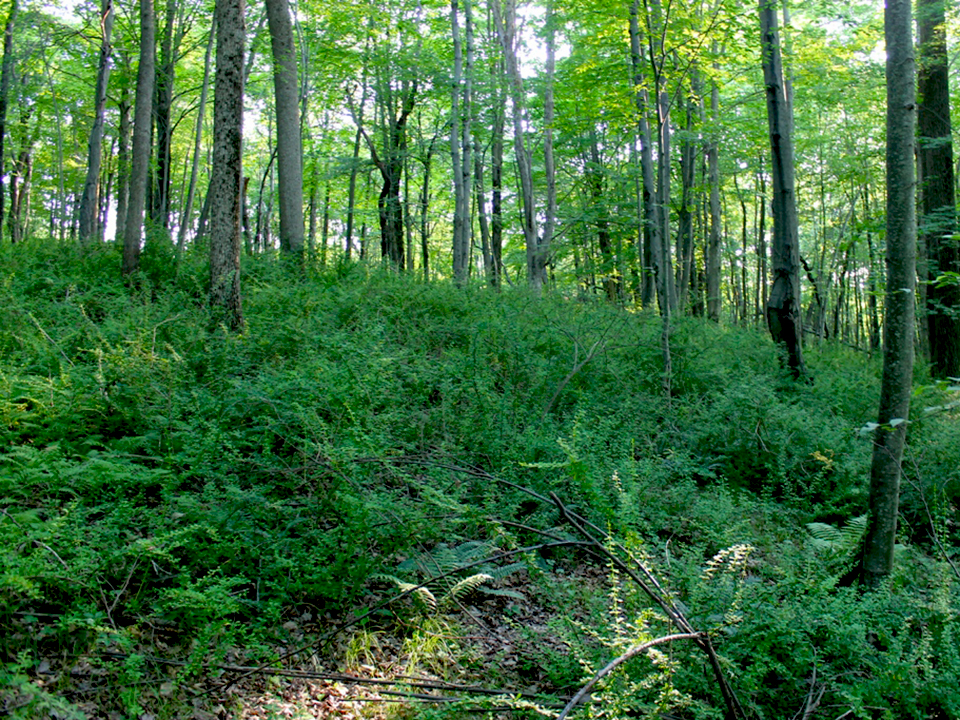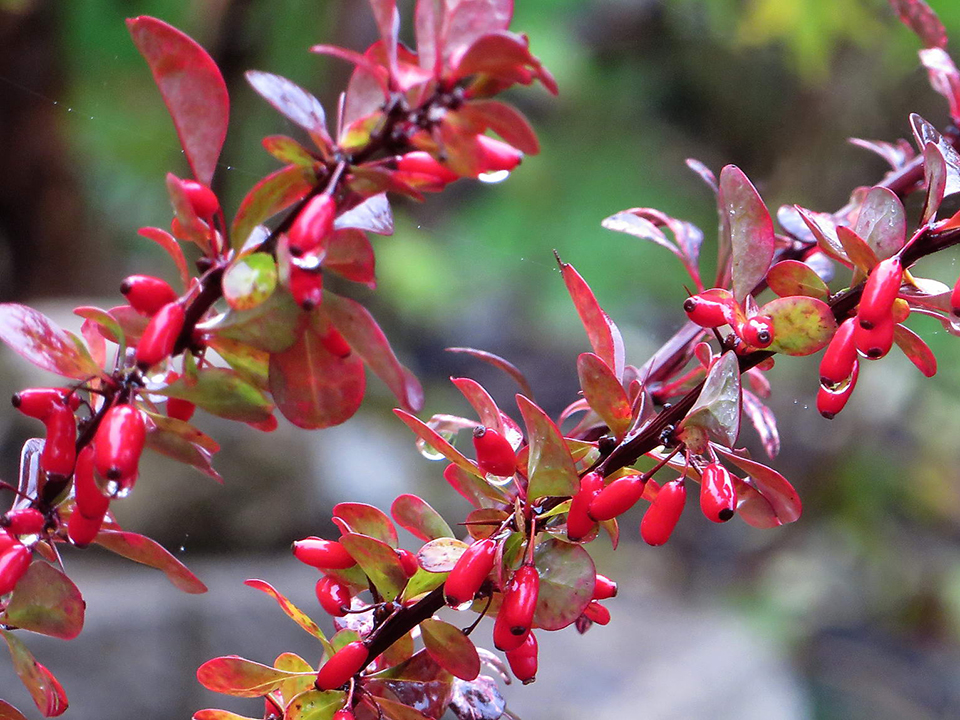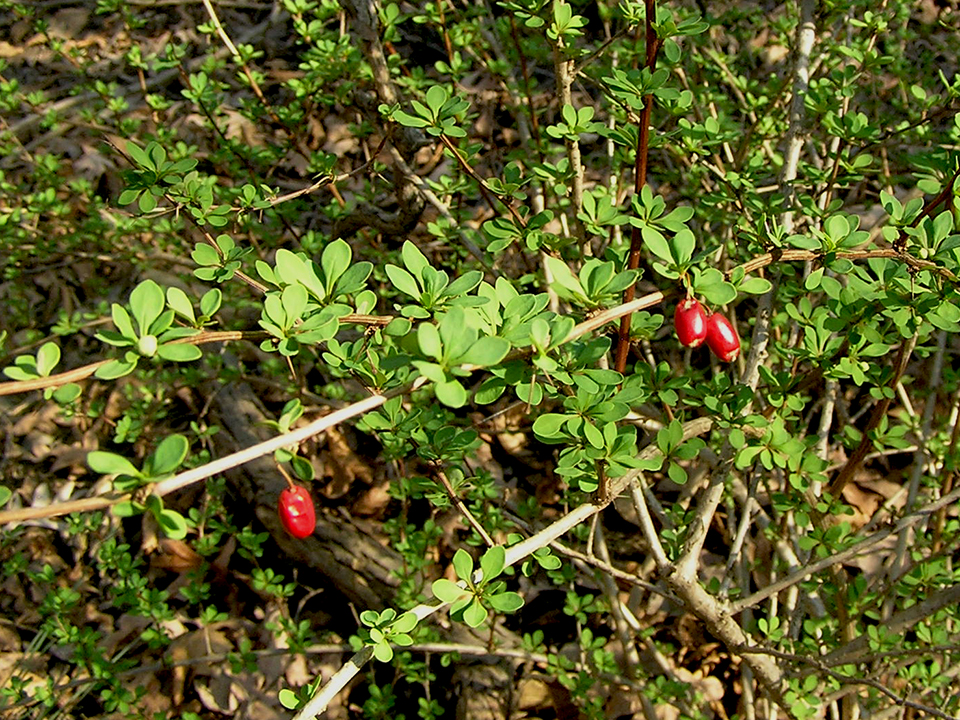Barberry foliage in early spring before the leaves of the native trees and shrubs leaf out. the plant is easy to find and erradicate at this time of year.
Species Name: Berberis thunbergii, Berberis vulgaris
Common Name: Japanese Barberry, Common Barberry
Origin: Japanese Barberry: Japan,
Common Barberry: Europe, North Africa and parts of Asia.
Distribution: grows in the understory of woodlands throughout the northeast
Identification: Japanese barberry is densely branched spiny shrub growing 3 to 5 ft high. Common barberry may grow to 10 ft tall with long thick arching stems. The leaves are small ½ to 1” round to oval shaped, they are light green in the spring turning to bluish green in summer. Fruits are crimson red in fall, the size of a raisins spaced along the stems. The long thin stems of barberry emerge from the root system and tend to arch with little lateral branching.
Diagnostic characteristics: Japanese barberry can be easily identified from other plants in early spring as it leafs out before most native shrubs leaf out. Look for bright green foliage and tiny oval leaves. Each slender stem is lined with short sharp spines at each leaf node, few native plants have similar spines. The fruit of barberry are the size and shape of dried raisins and turn a crimson color in early fall. The fruit persist on the stems into winter. The pith and heartwood of barberry stems are a bright yellow color, easily identifiable when stems are cut. Barberry fall color is a noticeable reddish orange which makes fall identification easy.
Biology and Spread: Barberry is adaptable to a wide range of growing conditions. It can grow in full sun or shade in dry or wet soils. Barberry produces large quantities of seed that have a high germination capacity and barberry will set fruit even in dense shade. Barberry fruit are readily eaten and dispersed by birds and small mammals. The foliage of barberry is not eaten by deer. In areas with high deer populations heavy browsing on native vegetation favors the proliferation of barberry.
Ecological threats: Once a few plants become established barberry can rapidly expand from seed dispersal and its tolerance of both shade and sun and quickly dominate a site excluding other native plants from growing. The spines of barberry make walking and human recreation difficult.
Control methods:
1) Cut Stump Treatment:
Cut stump treatment is one method for controlling large barberry and large numbers of plants. A brush saw is the most efficient tool for cutting barberry because of the sharp spines and large numbers of flexible stems. Each cut stem needs to be treated with a herbicide to prevent resprouting. A 10% to 15% solution of glyphosate (the active ingredient in Round-up) is applied to the cut surface. A hand held spray bottle works well for applying the herbicide to the cut stem. Add a spray colorant to the bottle so you can tell which stems have been treated. For a few plants loppers may be used but remember to treat each cut stem.
2) Foliar treatments
Large numbers of barberry plants may be more efficiently controlled using a foliar herbicide spray. Wait until mid to late summer. Spray the foliage thoroughly with herbicide. Use a 2% solution of glyphosate with a spray adjuvant.
Wait a week or two and then evaluate whether to retreat any missed plants.
Follow up treatments and monitoring will be needed in subsequent years to control new seedlings and missed plants.
3) Manual Control
Barberry has a weak root system. Plants may be dug with a shovel or mattock or pulled out by hand or with a weed wrench. Wear heavy leather gloves to protect yourself from the spines. Small plants are easily pulled by hand.
Barberry foliage in early spring before the leaves of the native trees and shrubs leaf out. the plant is easy to find and erradicate at this time of year.

Barberry in the understory of a forest in summer. Note how barberry has spread and dominates the understory.

Barberry fruit in fall. Note the sharp spines at each leaf node.

Barberry fruit and foliage. Note the tiny spoon shaped leaves in whorled clusters.